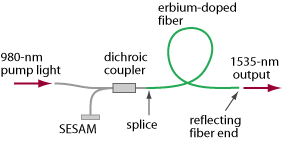Fiber lasers are particularly suitable for realizing upconversion lasers, which usually operate on relatively infrequent laser transitions and require very high pump intensities. In fiber lasers, high pump intensities can be maintained over long distances, so that the gain efficiency obtained is easily achieved for transitions with very low gain.
In den meisten Fällen sind Silica-Fasern nicht für Upconversion-Faserlaser geeignet, da der Upconversion-Mechanismus eine lange Zwischenzustandslebensdauer in der elektronischen Energieebene erfordert, die in Silica-Fasern aufgrund der hohen Phonon-Energie in der Regel sehr klein ist (siehe Multiphotonenübergänge). Daher werden in der Regel einige Schwermetallfluoridfasern verwendet, wie ZBLAN (ein Fluorozirkonat) mit niedriger Phononenergie.
Die am häufigsten verwendeten Upconversion-Faserlaser sind Thorium-dotierte Fasern für blaues Licht, Praseodymium-dotierte Laser (manchmal mit Ytterbium) für rotes, oranges, grünes oder blaues Licht und Erbium-dotierte Laser für Triode.
Faserlaser mit schmaler Linienbreite
In most cases, silica fibers are not suitable for upconversion fiber lasers, because the upconversion mechanism requires a long intermediate state lifetime in the electronic energy level, which is usually very small in silica fibers due to the high phonon energy (see multiphoton transitions). Therefore, some heavy metal fluoride fibers are usually used, such as ZBLAN (a fluorozirconate) with low phonon energy.
The most commonly used upconversion fiber lasers are thorium-doped fibers for blue light, praseodymium-doped lasers (sometimes with ytterbium) for red, orange, green or blue light, and erbium-doped lasers for triode.
Narrow-linewidth fiber lasers
Fiber lasers may operate in only a single longitudinal mode (see single-frequency laser, single-mode operation) with a very narrow linewidth of a few kilohertz or even less than 1 kHz. For long-term stable single-frequency operation, and without additional requirements after considering temperature stability, the laser cavity should be short (e.g., 5 cm), although the longer the cavity, in principle, the lower the phase noise and the narrower the linewidth. The fiber end contains a narrowband fiber Bragg grating (see distributed Bragg reflector laser, DBR fiber laser) to select a cavity mode. The output power typically ranges from a few milliwatts to tens of milliwatts, and single-frequency fiber lasers with output powers up to 1 W are also available.
An extreme form is the distributed feedback laser (DFB laser), where the entire laser cavity is contained within a fiber Bragg grating with a phase shift in between. Here the cavity is relatively short, which sacrifices output power and linewidth, but single-frequency operation is very stable.
Fiber amplifiers can also be used to further amplify to higher powers.
Q-switched fiber lasers
Fiber lasers can generate pulses with lengths ranging from tens to hundreds of nanoseconds, using various active or passive Q switches. Pulse energies of a few millijoules can be achieved with large mode area fibers, and in extreme cases can reach tens of millijoules, limited by the saturation energy (even with large mode area fibers) and the damage threshold (more pronounced for shorter pulses). All fiber devices (except free-space optics) are limited in pulse energy, because they usually cannot implement large mode area fibers and effective Q switching.
Due to the high laser gain, the Q-switching in fiber lasers is very different in nature from that in bulk lasers and is more complex. There are usually multiple spikes in the time domain, and it is also possible to produce Q-switched pulses with a length less than the resonator round-trip time.
Mode-locked fiber lasers use more complex resonators (ultrashort fiber lasers) to produce picosecond or femtosecond pulses. Here, the laser resonator contains an active modulator or some saturated absorbers. Saturated absorbers can be realized by nonlinear polarization rotation effects or by using a nonlinear fiber loop mirror. Nonlinear loop mirrors can be used, for example, in the "figure-of-eight laser" in Figure 8, where the left side contains a main resonator and a nonlinear fiber ring for amplifying, shaping and stabilizing the round-trip ultrashort pulses. Especially in harmonic mode locking, additional devices are required, such as subcavities used as optical filters.


